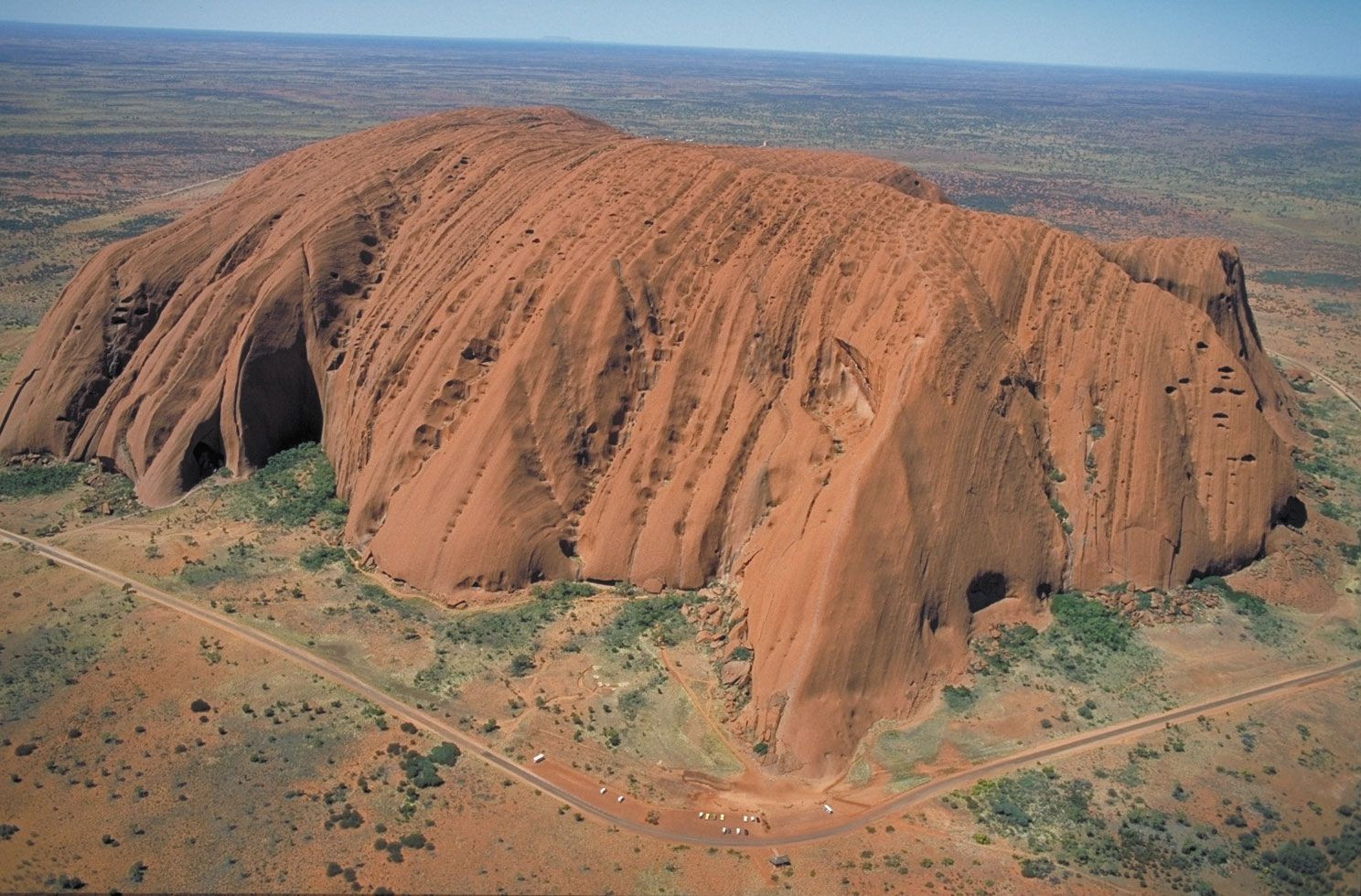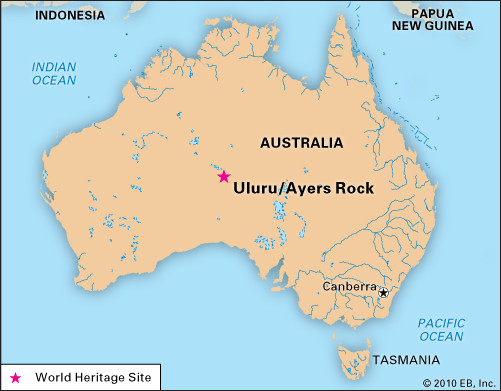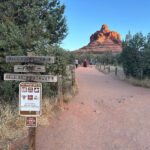Where Is Uluru Rock? Uluru Rock, also known as Ayers Rock, is located in the heart of Australia’s Northern Territory, specifically within the Uluru–Kata Tjuta National Park. This iconic sandstone formation is not just a geographical landmark; it’s a symbol of Australia’s natural and cultural heritage, offering breathtaking views and a deep connection to the Aboriginal culture. Discover the unique appeal of incorporating natural stone into your own landscapes at rockscapes.net. Explore diverse rock types and innovative design ideas to elevate your outdoor spaces with timeless beauty.
Table of Contents
- What is Uluru Rock and Where Is It?
- What Makes Uluru Rock So Special?
- How Was Uluru Rock Formed?
- What is the Cultural Significance of Uluru Rock?
- What Can You Do at Uluru–Kata Tjuta National Park?
- What Kind of Wildlife Can You See Around Uluru Rock?
- When Is the Best Time to Visit Uluru Rock?
- Where Can You Stay When Visiting Uluru Rock?
- Why Is Uluru Rock Important for Landscape Design?
- How Can You Incorporate Uluru-Inspired Elements Into Your Landscape?
- What Are Some Alternative Rock Features for Landscaping in the USA?
- FAQ About Uluru Rock
1. What is Uluru Rock and Where Is It?
Uluru, also known as Ayers Rock, is a massive sandstone monolith located in the southwestern part of the Northern Territory in Australia. Rising 1,142 feet (348 meters) above the surrounding desert plain, with a total height of 2,831 feet (863 meters) above sea level, it’s a prominent landmark within the Uluru–Kata Tjuta National Park. This park is situated approximately 280 miles (450 km) southwest of Alice Springs, making it a central feature of the Australian Outback. The rock itself is oval-shaped, measuring 2.2 miles (3.6 km) in length and 1.5 miles (2.4 km) in width, with a circumference of 5.8 miles (9.4 km). Its remote location and imposing size make it a significant natural attraction.
Uluru’s precise coordinates are 25.3447° S, 131.0367° E. This places it almost exactly in the center of the Australian continent, contributing to its iconic status as the “Red Centre”. The surrounding landscape is characterized by flat, arid plains dotted with desert vegetation, providing a stark contrast to the towering rock formation. This contrast enhances the visual impact of Uluru, making it appear even more dramatic against the horizon. The area is accessible via the nearby Yulara airport, which accommodates scheduled flights, and by road from Alice Springs, facilitating visits from both domestic and international tourists.
2. What Makes Uluru Rock So Special?
Uluru Rock’s special appeal comes from a combination of geological uniqueness, striking visual characteristics, and deep cultural significance. Geologically, Uluru is an inselberg, an isolated rock hill rising abruptly from a virtually level surrounding plain, making it a remarkable formation. Its composition of arkosic sandstone, rich in feldspar, causes the rock to change color dramatically with varying light conditions, especially during sunrise and sunset when it glows with fiery orange and red hues. According to research from Arizona State University’s School of Earth and Space Exploration, the rock’s unique mineral composition interacts with sunlight to create these stunning visual effects.
Culturally, Uluru holds immense importance for the local Aboriginal peoples, particularly the Anangu, who consider it a sacred site. The base of Uluru is adorned with caves containing ancient carvings and paintings that tell stories of their ancestors and the creation period known as Tjukurpa. In 1985, the Australian government officially recognized the traditional ownership of Uluru by the Anangu people, leasing the rock and surrounding park back to the government for 99 years. This act of recognition underscores the deep spiritual connection between the Aboriginal people and Uluru. In 1987, Uluru was designated a UNESCO World Heritage site for its natural values, and in 1994, it received a second designation for its cultural significance, highlighting its universal importance.
3. How Was Uluru Rock Formed?
The formation of Uluru Rock is a geological story spanning over 500 million years. It began during the Petermann Orogeny, a period of mountain building in central Australia. The region was once an ancient seabed, and sediments, including sand and gravel rich in feldspar, were deposited over millions of years. According to Geoscience Australia, these sediments were compressed and cemented together to form arkosic sandstone.
The tilting and folding of the Earth’s crust during the Alice Springs Orogeny around 300 to 400 million years ago caused the rock layers to be uplifted and tilted almost vertically. Over millions of years, the softer surrounding rock eroded away, leaving the more resistant arkosic sandstone of Uluru exposed. The monolith’s distinctive fluted sides and gullies are the result of ongoing erosion from infrequent but powerful rainstorms. The weathering processes continue to shape Uluru, slowly revealing its layered composition and creating its unique textures and formations.
 Close-up of Uluru's surface, showcasing the arkosic sandstone composition and the effects of weathering
Close-up of Uluru's surface, showcasing the arkosic sandstone composition and the effects of weathering
4. What is the Cultural Significance of Uluru Rock?
Uluru Rock holds profound cultural significance for the Anangu people, the traditional custodians of the land. For them, Uluru is not just a rock; it is a living cultural landscape imbued with the stories of their ancestors and the Tjukurpa (creation time). The rock’s caves and markings are believed to be physical evidence of ancestral beings and their activities during the creation period.
The Anangu people have a deep spiritual connection to Uluru, and their traditional laws and customs are closely tied to the land. They perform ceremonies and rituals at specific sites around Uluru, maintaining their cultural heritage and passing down knowledge through generations. The rock art found in the caves at the base of Uluru depicts stories, ceremonies, and important symbols that are integral to their cultural identity. According to the Uluru–Kata Tjuta National Park management, respecting the cultural significance of Uluru is paramount, and visitors are encouraged to learn about and appreciate the Anangu culture.
5. What Can You Do at Uluru–Kata Tjuta National Park?
Uluru–Kata Tjuta National Park offers a range of activities for visitors to experience the natural and cultural wonders of the region. Hiking around the base of Uluru is a popular activity, allowing visitors to appreciate the rock’s scale and discover its various formations and caves. Several trails are available, including the Mala Walk, which offers insights into Anangu culture and rock art, and the Mutitjulu Waterhole Walk, which leads to a serene natural spring.
The park also includes Kata Tjuta (The Olgas), a group of 36 domed rock formations located about 20 miles (32 km) west of Uluru. Visitors can explore Kata Tjuta through the Valley of the Winds Walk and the Olga Gorge Walk, which provide stunning views of the unique landscape. Cultural experiences are a significant part of visiting Uluru–Kata Tjuta National Park. The park’s Cultural Centre offers exhibits and information about Anangu culture, history, and art. Visitors can participate in guided tours led by Aboriginal guides, learning about the Tjukurpa stories and the significance of the land.
6. What Kind of Wildlife Can You See Around Uluru Rock?
Despite the arid climate, the landscape around Uluru Rock supports a diverse array of flora and fauna. The park is home to about 400 plant species, including mulga trees, desert oaks, and centralian bloodwoods. Shrubs like Grevillea and various wildflowers, such as foxtails and myrtles, add color to the desert landscape, especially after rainfall.
Wildlife in the area includes mammals such as red kangaroos, rodents, and small marsupials. Reptiles are abundant, with numerous lizards, geckos, skinks, and snakes, including poisonous varieties like the death adder. The moloch, or thorny devil, is a distinctive reptile found in the park. According to park surveys, there are approximately 175 bird species, including falcons, buzzards, budgerigars, and honeyeaters. These birds are well-adapted to the desert environment and play important roles in the ecosystem.
7. When Is the Best Time to Visit Uluru Rock?
The best time to visit Uluru Rock is during the cooler months of the year, from May to September. During this period, the weather is more temperate, with daytime temperatures ranging from 68°F to 86°F (20°C to 30°C). This makes it more comfortable for hiking and exploring the park’s attractions.
The summer months, from December to February, can be extremely hot, with daytime temperatures often exceeding 105°F (40°C). These high temperatures can make outdoor activities challenging and potentially dangerous. Winter nights can be cold, with temperatures occasionally dropping below freezing, so it’s important to pack warm clothing if visiting during this time. According to the Bureau of Meteorology, rainfall is variable but most likely to occur from January to March. Visiting during the shoulder seasons (April-May and September-October) can also be a good option, offering a balance of pleasant weather and fewer crowds.
8. Where Can You Stay When Visiting Uluru Rock?
When visiting Uluru Rock, the primary accommodation hub is Yulara, a resort town located just north of the Uluru–Kata Tjuta National Park boundary. Yulara offers a range of lodging options to suit different budgets and preferences. Ayers Rock Resort, managed by Voyages Indigenous Tourism Australia, provides various types of accommodation, from luxury hotels to self-contained apartments and a campground.
The Sails in the Desert is a luxury hotel offering spacious rooms and a range of amenities, while the Desert Gardens Hotel provides comfortable accommodation with views of the surrounding desert landscape. For budget-conscious travelers, the Outback Pioneer Hotel offers affordable rooms and a lively atmosphere. The Emu Walk Apartments provide self-contained accommodation with kitchen facilities, ideal for families and those who prefer to prepare their own meals. The Ayers Rock Campground offers powered and unpowered campsites for those who enjoy camping. There are no overnight accommodations within the national park itself to preserve the natural environment.
9. Why Is Uluru Rock Important for Landscape Design?
Uluru Rock, with its striking presence and rich cultural history, serves as a powerful source of inspiration for landscape design. Its imposing form and the surrounding Australian Outback evoke a sense of grandeur and natural beauty that can be translated into unique and captivating outdoor spaces. The rock’s color-changing properties, influenced by sunlight, offer a dynamic visual element that can be emulated through the careful selection of materials and plants.
The textures and patterns found on Uluru, shaped by centuries of erosion, provide a wealth of design ideas for creating tactile and visually engaging landscapes. The use of native Australian plants, which thrive in the arid conditions around Uluru, can bring an authentic touch to garden designs, creating landscapes that are both aesthetically pleasing and environmentally sustainable. By incorporating elements inspired by Uluru, designers can create outdoor spaces that tell a story, connect with nature, and celebrate the unique beauty of the Australian landscape. Rockscapes.net offers a variety of natural stone options and design inspirations to help you capture the essence of Uluru in your own landscape projects.
10. How Can You Incorporate Uluru-Inspired Elements Into Your Landscape?
Incorporating Uluru-inspired elements into your landscape design can bring the dramatic beauty and cultural richness of the Australian Outback to your own backyard. Here are some ideas to consider:
- Use of Red Earth Tones: Choose materials and plants that reflect the warm, earthy tones of Uluru and the surrounding desert. Reddish-brown gravel, pavers, and mulches can create a foundation that evokes the iconic landscape.
- Native Australian Plants: Incorporate native Australian plants that are well-suited to arid conditions. Consider species like eucalyptus, acacia, grevillea, and kangaroo paw, which offer a range of textures, colors, and forms.
- Rock Formations: Use large rocks and boulders to create focal points that mimic the imposing presence of Uluru. Arrange these rocks in a way that suggests natural erosion and weathering, creating a sense of timelessness.
- Textural Variety: Emphasize textural variety in your plant selections and hardscape materials. Combine smooth river stones with rough-hewn boulders, and mix fine-textured grasses with bold, sculptural plants.
- Water Features: Incorporate dry creek beds or minimal water features to represent the ephemeral water sources found in the Australian Outback. Use rocks and gravel to create the impression of a dry riverbed that comes to life after rainfall.
- Indigenous Art: Consider incorporating Aboriginal art or designs into your landscape through the use of painted rocks, mosaic pathways, or sculptural elements. This can add a layer of cultural significance and storytelling to your design.
- Sunset Lighting: Utilize lighting to replicate the dramatic color changes that occur on Uluru during sunrise and sunset. Use warm-toned lights to illuminate rock formations and plants, creating a captivating visual display.
By thoughtfully integrating these elements, you can create a landscape that captures the essence of Uluru and brings the spirit of the Australian Outback to your outdoor space.
 Example of a landscape design incorporating red earth tones, native plants, and rock formations inspired by Uluru
Example of a landscape design incorporating red earth tones, native plants, and rock formations inspired by Uluru
11. What Are Some Alternative Rock Features for Landscaping in the USA?
While Uluru is a unique and iconic landmark, its essence can be translated into landscape designs using locally available materials. Here are some alternative rock features that can be used in landscaping across the USA, depending on regional availability and aesthetic preferences:
| Feature | Description | Regional Availability | Aesthetic |
|---|---|---|---|
| Desert-Inspired Rock Gardens | Incorporating arid-climate plants and rock formations, xeriscaping principles. | Southwestern USA (Arizona, New Mexico, Nevada, California) | Arid, minimalist, naturalistic |
| Granite Boulders | Large granite rocks used as focal points or retaining walls. | New England, Rocky Mountains, California | Rugged, timeless, versatile |
| Sandstone Outcroppings | Layered sandstone formations mimicking natural cliffs or canyon walls. | Southwestern USA (Utah, Arizona), Midwest | Warm, earthy, textured |
| River Rock Beds | Using smooth river rocks to create dry creek beds or decorative ground cover. | Nationwide, especially near rivers and streams | Natural, calming, versatile |
| Slate Walls | Building walls or pathways using flat pieces of slate. | Northeastern USA, Appalachian region | Modern, elegant, layered |
| Fieldstone Features | Utilizing irregularly shaped fieldstones for walls, borders, or garden accents. | Northeastern USA, Midwest | Rustic, charming, informal |
These alternatives can help create landscapes that evoke the spirit of Uluru while utilizing materials that are appropriate for the local environment and design style. Rockscapes.net offers a wide selection of natural stones and expert advice to help you choose the perfect materials for your landscaping project.
12. FAQ About Uluru Rock
Here are some frequently asked questions about Uluru Rock:
1. What is Uluru made of?
Uluru is composed of arkosic sandstone, which is a type of sandstone rich in the mineral feldspar.
2. How tall is Uluru?
Uluru rises 1,142 feet (348 meters) above the surrounding desert plain and reaches a height of 2,831 feet (863 meters) above sea level.
3. Can you climb Uluru?
Climbing Uluru is no longer permitted out of respect for the wishes of the local Anangu people, who consider it a sacred site.
4. What does Uluru mean?
The name “Uluru” is an Aboriginal word with a meaning that is not widely known to outsiders but is deeply significant to the Anangu people.
5. Who owns Uluru?
Official ownership of Uluru was given to the local Aboriginal people in 1985, who lease the rock and the national park to the federal government for 99 years.
6. How old is Uluru?
Uluru began forming over 500 million years ago.
7. What animals live near Uluru?
The area around Uluru is home to various animals, including red kangaroos, reptiles like lizards and snakes, and numerous bird species.
8. Is Uluru a World Heritage Site?
Yes, Uluru and the surrounding Uluru–Kata Tjuta National Park are a UNESCO World Heritage site, recognized for both their natural and cultural significance.
9. What is the best time to visit Uluru?
The best time to visit Uluru is during the cooler months, from May to September, when the weather is more temperate.
10. How do you get to Uluru?
Most visitors arrive at Uluru via Alice Springs and then drive or take a tour bus to the Uluru–Kata Tjuta National Park. There is also a small airport at Yulara with scheduled flights.
Ready to bring the awe-inspiring beauty of natural stone into your own landscape? Visit rockscapes.net today for inspiration, expert advice, and a wide selection of premium stones to create the outdoor space of your dreams!
